Abstract
This study examines the mechanical properties of thermoplastic polymer composites manufactured by utilizing different side-stream materials as fillers. Two composites were manufactured from side-stream materials from the construction industry, two were manufactured from side-stream materials from the paper industry, and one was manufactured from side-stream materials from a coating factory. The matrix polymer used in the composites originated from recycling facility. The side-stream materials were used as fillers. One composite was manufactured as a reference by using wood-fiber as the filler. The tensile properties and impact strength were tested. The materials were also observed with a scanning electron microscope. Compared to the reference material, tensile strength and modulus decreased in all cases except for the sludge from the paper industry. The sludge also improved the impact strength remarkably, as the impact strength with the stone wool and stone dust from the construction industry remained the same, while the values were weakened for the others. Scanning electron microscope images showed that powder coating waste from the coating factory increased porosity and, thus, decreased the density of the material.
1. Introduction
Awareness of the reduction of non-renewable sources increased, and there is a desire for a more sustainable environment [1]. Due to the tightening legislation in the European Union (EU), more resource-efficient and sustainable waste management is required [2]. Polymer composites are one alternative for recycling materials or utilizing side-streams which otherwise would be discarded. A wide range of materials were used for this purpose, such as rice straw, deinked newspaper, and chicken feather fibers [3,4,5,6]. One way to classify fillers in polymers is to divide them into two classes: organic and inorganic [7]. Several incentives guided the utilization of these waste materials. Mineral fillers were used to decrease the price of plastic, and natural fibers as fillers in plastic enhance material properties and give a more environmentally friendly characteristic to the material [8]. Mineral fillers increase the stiffness and the flame retardancy of plastic, for example [9]. Using recycled materials instead of virgin ones makes the use of the filler even more meaningful, from the environmental point of view.
The study of using different waste fractions as fillers for polymers increased in recent years. Different materials from various fields were tested. One of the most often studied areas is natural fiber polymer composites. Various types of fibers from different parts of a plant can be used as a filler [10]. Several studies were conducted, for example, on paper mill sludge that was utilized as a filler in a polymer [11,12]. Primary sludge can also be utilized as a material for energy production [13]. Recycled cellulose was also a topic of research [14].
One group of materials utilized in this study is side-streams from the insulation industry. Mineral-based materials as fillers in polymer composites are not studied as much as natural fiber products. Usually, mineral wool is used as a recycled material, not a virgin one as in this case. For high-quality raw material, mineral wool has to be separated properly from other construction and demolition (C&D) waste [15]. Väntsi and Kärki [16] used recycled mineral wood as a filler in a wood–plastic composite. Rock wool waste was used in the manufacturing of a cement-based composite [17]. The last material used in this study was waste from a powder coating factory. This type of material is quite a new area of research, but Souza et al. [18] studied composite manufacturing using ink waste as an adhesive. With these materials, it was possible to manufacture more environmentally friendly products, without using virgin materials as much.
In this study, six different composites were manufactured by using fillers from industrial side-streams. The purpose of the study was to investigate how the selected filler materials change the mechanical properties of polymer composites. Materials selected for this study are underutilized; thus, this research has the potential to bring new application fields for materials that are not effectively used at this moment. Side-streams from different industries create a steady material flow with uniform quality that has the potential to be utilized as a filler in polymer composites.
2. Materials and Methods
2.1. Materials
Different types of side-flow materials from different industries were used. Six different composites were manufactured from these materials. The composites were loaded equally with fillers; the type of the filler was the only factor that varied. All composites were made from recycled high-density polyethylene (HDPE) with a total loading percentage of 50% by weight, including 3% coupling agent MAPE (anhydride modified polyethylene, Fusabond E226) and 3% lubricant (struktol TPW 113, Structol Company of America, LLC). Recycled HDPE in the stone wool and stone dust composite had an MFI (Melf flow index) of 0.5 and recycled HDPE used in the remaining composites had an MFI of 8. The filler content was 44% and the filler type differed between composites. The powder coating composite contained 10% powder coating waste, and 34% was wood flour. The reference contained only wood flour (spruce, sieved to mesh size 20 (0.84 mm)) as a filler. The amounts of filler types in composites are presented above as weight percentages. Table 1 below shows the fillers used for the composites.

Table 1.
Filler types in the composite.
The material made from wood flour was considered as a reference. The stone wool filler and stone dust filler were from the same insulation factory. Stone wool was a fibrous side-stream generated from sawing and surface grinding the cured insulation slabs and boards. Stone dust was side-stream material from the factory, collected from the stone drying units. Powder coating waste was from a coating factory, including cleaning materials from a central vacuum cleaner, cyclone dust from a grinding mill, and local exhaust ventilation from a manufacturing site. Primary sludge and cellulose were side-streams from a paper mill. Cellulose was accumulated into the drying machine from the drying process of cellulose. Primary sludge was generated in the pre-clarification of a wastewater treatment plant. The plastic used as a matrix in all composites was recycled HDPE received from a waste recycling station. The reference composite was manufactured from wood fiber and recycled plastic.
2.2. Methods
The composites were manufactured by extrusion. Before extrusion, the materials were agglomerated with a PLASMEC TRL 100/FV/W turbomixer to mix all the components. The formed pellets were extruded with a Battenfeld Cincinnati FiberEX 38 conical counter-rotating twin-screw extruder. The material was formed into a plate with an objective thickness of 3 mm. The die temperature varied between 144 and 176 °C and the screw speed was 16–24 rpm, as can be seen in Table 2. The output of the material varied between 6.9 and 14 kg/h. The values in the manufacturing phases differed between the composites due to the differences in composite materials.

Table 2.
Manufacturing parameters for extrusion.
The tensile properties, density, and Charpy impact strength of the samples were tested. In total, 20 samples of each material were tested in all tests. The test samples were cut from the extruded profile. The density of the materials was determined according to standard EN 323 [19]. The density of the samples was determined by cutting the samples in squares, with a nominal length of 50 mm and thickness equal to the extruded profile. The tensile properties were investigated according to the EN ISO 527-2 standard [20] with a Zwick Z020 (Zwick Roell group) testing apparatus. Tested samples were dumbbell-shaped, with a full length of 150 mm, 10-mm width in the narrow portion, and thickness equal to the extruded profile. The impact properties were tested according to EN 179-1 with a Zwick 5102 impact tester using method ISO 179-1/1fUc. [21]. Impact strength was measured with un-notched samples with a flatwise measurement using 80-mm-length samples, with a width of 10 mm, and thickness equal to the extruded profile. All used standards were selected from recommendation of standard SFS-EN 15534-1 [22]. A Hitachi SU3500 scanning electron microscope (SEM) was used for the detailed morphological characterization of the materials. SEM figures were taken from the cross-section of fracture surface of the tensile samples. Figure 1 presents the extruded materials.
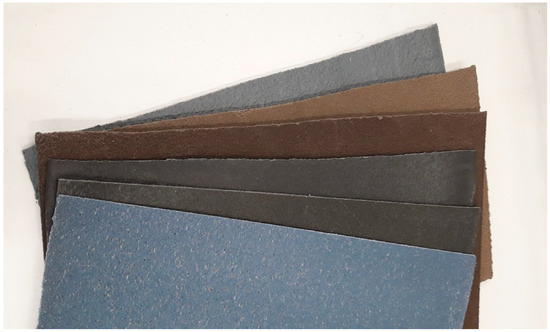
Figure 1.
Extruded composites (from bottom to top): reference, stone wool, stone dust, primary sludge, cellulose, and powder coating.
3. Results and Discussion
3.1. Density
Table 3 presents the densities of the composites. As can be seen, mineral fillers increased the density, while the wood-based materials slightly decreased it. The powder coating material had a clearly lower density than any of the other composites. Mineral fillers increased the density of the composites [23]; thus, it was expected that stone wood and stone dust would increase the density.

Table 3.
Densities of the composites.
Composites contained some porosity, depending on the materials and variables in the manufacturing methods [9].
3.2. Tensile Properties
Figure 2 shows the tensile strengths of different composites. Sludge and the reference clearly had the highest values, whereas the four other composites were obviously weaker. It has to be noted that the standard deviation of the sludge was quite large, but the value was still better than in the other composites, except for the reference. Huang et al. [24] studied paper mill sludge as a replacement for wood fibers. They found that paper mill sludge did not improve the tensile strength properties but lowered them slightly. Lahtela et al. [12] showed that primary sludge had similar tensile properties to wood fibers. Similar results were obtained in this study.
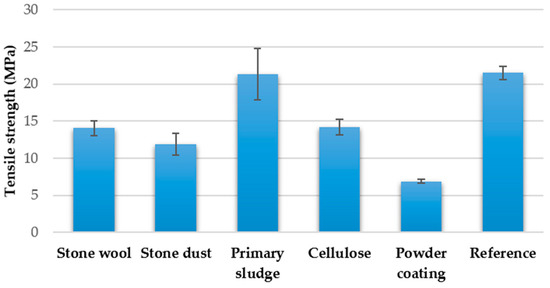
Figure 2.
Tensile strength of the composites.
In a study by Väntsi and Kärki [16], part of the wood material in a wood–plastic composite was replaced with mineral wool, which decreased the tensile properties of the composite. Gwon et al. [25] added plate-shaped talc to a wood–plastic composite. Similarly to the present study, they found that the mineral filler decreased the tensile strength. However, it has to be taken into account that different mineral fillers have properties that may vary greatly. Different mineral structures, aspect ratios, and surface charges influence the properties of the polymers greatly [26]. Based on the information received from Figure 2, it can be noted that primary sludge composite was the only one that could compete with the reference in terms of tensile strength properties.
The tensile modulus shown in Figure 3 was in line with the tensile strength properties, with the exception that the modulus of sludge was lower than that of the reference material. The standard deviation of the reference materials was quite large, but the value of the modulus was still significantly higher compared to the others. Standard deviation in the other materials was quite small. Lahtela et al. [12] discovered that primary sludge improved the tensile modulus of a composite slightly. In the present case, opposite results were found. Rizvi and Semeralul [27] investigated the addition of glass fiber to a wood–plastic composite. They noted that glass wool improved the mechanical properties of the composite. However, glass wool was not used with wood fibers alone. Väntsi and Kärki [16] also noted that inorganic fibers decreased the tensile modulus of the composite.
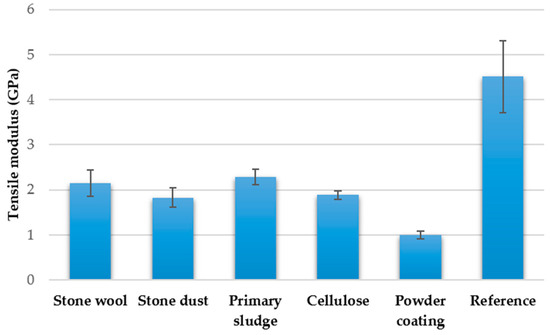
Figure 3.
Tensile modulus of the composites.
3.3. Impact Properties
The impact strength values of the composites in Figure 4 were quite alike except for the primary sludge, which clearly had better impact strength values than the other materials. However, the standard deviation of values for the sludge composite samples was quite large, but the result was still better than with the other composites. Huang et al. [24] found that paper mill sludge improved the impact strength. Lahtela et al. [12] also found that sludge improved the impact strength compared to a filler from wood flour. Migneault et al. [28] came to the same conclusion while comparing wood fibers and different pulps from a paper mill, and Keskisaari and Kärki [29] noted that carton cutting waste improved the properties of the composites. Väntsi et al. [16] found that mineral wool slightly increased the impact strength of a composite like the one in this study. Keskisaari et al. [30] also found that adding mineral wool to a composite increased impact strength. Huuhilo et al. [23] discovered that a mineral filler usually improved the impact strength of a wood–polymer composite (WPC), except in the case of talc. Mishra et al. [31] found that adding glass fiber to bio-based fiber composites increased the impact strength.
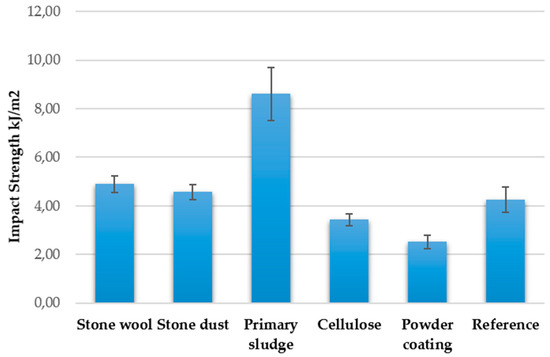
Figure 4.
Impact strength of the composites.
3.4. SEM
SEM figures confirmed the above, as the results in Figure 5 show. In Figure 5b, the filler is shown in fibrous form, and, in Figure 5c, it is shown in cubical form. In both cases, it can be seen that the filler was not fully connected to the matrix. This can be seen more clearly in Figure 6a,b. In Figure 6, the arrows show the poor coupling. In Figure 6a, there are slots from the fiber where the material was torn apart. The arrows also show that there were gaps between the matrix and fiber. Figure 6b shows that there were gaps between the matrix and filler, as shown by the arrows. Due to the poor interfacial adhesion of the filler and the matrix, the mechanical properties of the composite declined. The composites in Figure 5d,e seemed similarly smooth, but there was a clear difference between them in terms of impact and tensile strength values. Nothing in these figures could explain the difference. Compared to the reference material, where the wood material was wood flour, the composites made from paper mill waste looked smoother due to the different size of the fiber particles. The sample in Figure 5f differed from the other composites. As can be seen from the figure, the composite appeared to be full of cavities. This explains its weak tensile properties and low density. It also seems that fine particles attached to the fiber materials. If this coating of fibers prevents matrix adhesion to the fiber materials, it might explain the poor mechanical properties of the composites. The cavities formed during extrusion, presumably due to the incompatibility between HDPE and polyester and the vaporization of water. Although the mechanical properties of the powder coating composite were weak, one factor has to be taken into account. The density of the material was very low.
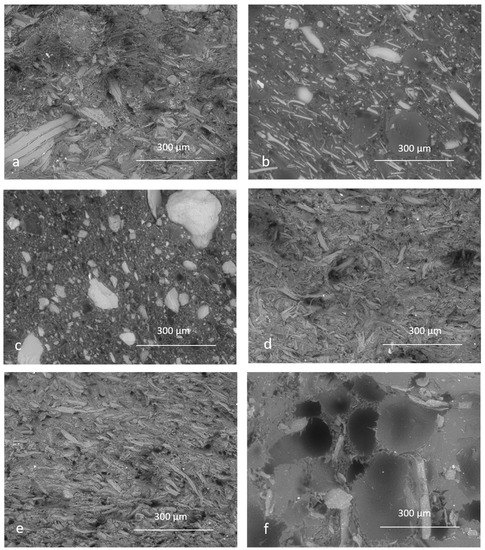
Figure 5.
Scanning electron microscope micrographs at 150× magnification for (a) reference composite, (b) stone wool, (c) stone dust, (d) primary sludge, (e) cellulose, and (f) powder coating.

Figure 6.
More detailed graphs from stone wool (a) and stone dust (b) composites.
4. Conclusions
This study examined several materials. The properties of the studied composites differed clearly from each other. Stone-based materials from the insulation industry did not improve the tensile properties of the composite, and the impact strength remained largely the same. Two side-stream materials from the paper industry differed from each other and from the reference material. Sludge was the better of these two, as its tensile strength was equal to the reference, but the impact strength was remarkably better than that of the reference. The mechanical properties of the powder coating composite were the poorest of all of the composites. However, powder coating waste clearly decreased the density of the composite. This property makes it useful for applications where low density of the material is required. Based on the properties tested in this article, primary sludge has promising properties for utilization as a polymer filler.
Based on the results got from this study, it can be noted that primary sludge is the only one of the manufactured composites that can compete with the reference in terms of its mechanical properties. Further studies are needed to investigate more properties. This study showed only a small part of the material properties, and more appropriate tests should be carried out to better understand the properties of the composites. While polymer composites are often used in outdoor applications, testing for different weather conditions would give an understanding of how outdoor stress affects the properties of the composites.
Author Contributions
Methodology, A.K.; material testing A.K.; writing—original draft preparation, A.K.; supervision, T.K.; contribution to the methodology, T.K.; writing—review and editing, T.V.
Funding
This study was supported by the RECOMPOSE project (7925/31/2016 and 7649/31/2016) by Business Finland.
Conflicts of Interest
The authors declare no conflicts of interest.
References
- Faruk, O.; Bledzki, A.K.; Fink, H.P.; Sain, M. Biocomposites reinforced with natural fibers: 2000–2010. Prog. Polym. Sci. 2012, 37, 1552–1596. [Google Scholar] [CrossRef]
- European Commission. Being wise with waste: The EU’s approach to waste management. Publ. Off. Eur. Union 2010, 1–18. [Google Scholar]
- Chen, S.; Cheng, L.; Huang, H.; Zou, F.; Zhao, H.P. Fabrication and properties of poly(butylene succinate) biocomposites reinforced by waste silkworm silk fabric. Compos. Part A Appl. Sci. Manuf. 2017, 95, 125–131. [Google Scholar] [CrossRef]
- Tawfik, M.E.; Eskander, S.B.; Nawwar, G.A.M. Hard wood-composites made of rice straw and recycled polystyrene foam wastes. J. Appl. Polym. Sci. 2017, 134, 1–9. [Google Scholar] [CrossRef]
- López, J.P.; Boufi, S.; El Mansouri, N.E.; Mutjé, P.; Vilaseca, F. PP composites based on mechanical pulp, deinked newspaper and jute strands: A comparative study. Compos. Part B Eng. 2012, 43, 3453–3461. [Google Scholar] [CrossRef]
- Zhan, M.; Wool, R.P. Mechanical properties of chicken feather fibers. Polym. Compos. 2011, 32, 937–944. [Google Scholar] [CrossRef]
- Fink, J.K. A Concise Introduction to Additives for Thermoplastic Polymers; John Wiley & Sons: Hoboken, NJ, USA, 2010; ISBN 9780470609552. [Google Scholar]
- Kim, J.K.; Pal, K. Overview of Wood-Plastic Composites and Uses; Springer: Berlin/Heidelberg, Germany, 2010; Volume 58, ISBN 978-3-642-14876-7. [Google Scholar]
- Klyosov, A.A. Wood-Plastic Composites; John Wiley & Sons: Hoboken, NJ, USA, 2007; ISBN 9780470148914. [Google Scholar]
- Mohanty, A.K.; Misra, M.; Drzal, L.T. Natural Fiber, Biopolymer, and Biocomposites; CRC Press: Borarton, FL, USA, 2005. [Google Scholar]
- Soucy, J.; Godard, F.; Rivard, P.; Koubaa, A. Rheological behavior of high-density polyethylene (HDPE) filled with paper mill sludge. J. Appl. Polym. Sci. 2018, 135, 46484. [Google Scholar] [CrossRef]
- Lahtela, V.; Mustonen, K.; Kärki, T. The effect of primary sludge on the mechanical performance of high-density polyethylene composites. Ind. Crops Prod. 2017, 104, 129–132. [Google Scholar] [CrossRef]
- Stoica, A.; Sandberg, M.; Holby, O. Energy use and recovery strategies within wastewater treatment and sludge handling at pulp and paper mills. Bioresour. Technol. 2009, 100, 3497–3505. [Google Scholar] [CrossRef]
- Espert, A.; Camacho, W.; Karlson, S. Thermal and thermomechanical properties of biocomposites made from modified recycled cellulose and recycled polypropylene. J. Appl. Polym. Sci. 2003, 89, 2353–2360. [Google Scholar] [CrossRef]
- Mulder, E.; de Jong, T.P.R.; Feenstra, L. Closed Cycle Construction: An integrated process for the separation and reuse of C&D waste. Waste Manag. 2007, 27, 1408–1415. [Google Scholar] [PubMed]
- Väntsi, O.; Kärki, T. Utilization of recycled mineral wool as filler in wood-polypropylene composites. Constr. Build. Mater. 2014, 55, 220–226. [Google Scholar] [CrossRef]
- Cheng, A.; Lin, W.T.; Huang, R. Application of rock wool waste in cement-based composites. Mater. Des. 2011, 32, 636–642. [Google Scholar] [CrossRef]
- Souza, A.M.; Nascimento, M.F.; Almeida, D.H.; Lopes Silva, D.A.; Almeida, T.H.; Christoforo, A.L.; Lahr, F.A.R. Wood-based composite made of wood waste and epoxy based ink-waste as adhesive: A cleaner production alternative. J. Clean. Prod. 2018, 193, 549–562. [Google Scholar] [CrossRef]
- The Finnish Standards Association SFS. Wood-Based Panels. Determination of Density; SF-EN 323; The Finnish Standards Association SFS: Helsinki, Finland, 1993. [Google Scholar]
- The Finnish Standards Association SFS. Plastics. Determination of Tensile Properties. Part 2: Test Conditions for Moulding and Extrusion Plastics; SF-EN ISO 527-2; The Finnish Standards Association SFS: Helsinki, Finland, 2012. [Google Scholar]
- The Finnish Standards Association SFS. Plastics. Determination of Charpy Impact Properties. Part 1: Non-Instrumented Impact Test; SF-EN ISO 179-1; The Finnish Standards Association SFS: Helsinki, Finland, 2010. [Google Scholar]
- The Finnish Standards Association SFS. Composites Made from Cellulose-Based Materials and Thermoplastics (Usually Called Wood-Polymer Composites (wpc) or Natural Fibre Composites(nfc)). Part 1: Test Methods for Characterisation of Compounds and Products; SF-EN 15534-1; The Finnish Standards Association SFS: Helsinki, Finland, 2014. [Google Scholar]
- Huuhilo, T.; Martikka, O.; Butylina, S.; Kärki, T. Mineral fillers for wood-plastic composites. Wood Mater. Sci. Eng. 2010, 5, 34–40. [Google Scholar] [CrossRef]
- Huang, H.B.; Du, H.H.; Wang, W.H.; Shi, J.Y. Characteristics of paper mill sludge-wood fiber-high-density polyethylene composites. Polym. Compos. 2012, 33, 1628–1634. [Google Scholar] [CrossRef]
- Gwon, J.G.; Lee, S.Y.; Chun, S.J.; Doh, G.H.; Kim, J.H. Effects of chemical treatments of hybrid fillers on the physical and thermal properties of wood plastic composites. Compos. Part A Appl. Sci. Manuf. 2010, 41, 1491–1497. [Google Scholar] [CrossRef]
- Dombrowski, T.; Mueller, S.; Gardner, D.; O’Neill, S. Effect of different mineral types upon the performance characteristics of WPC decking boards. In Proceedings of the Global Outlook for Natural Fiber & Wood Composites, Orlando, FL, USA, 14–16 November 2005; pp. 14–16. [Google Scholar]
- Rizvi, G.M.; Semeralul, H. Glass-fiber-reinforced wood/plastic composites. J. Vinyl Addit. Technol. 2008, 14, 39–42. [Google Scholar] [CrossRef]
- Migneault, S.; Koubaa, A.; Perré, P. Effect of fiber origin, proportion, and chemical composition on the mechanical and physical properties of wood-plastic composites. J. Wood Chem. Technol. 2014, 34, 241–261. [Google Scholar] [CrossRef]
- Keskisaari, A.; Kärki, T. Utilization of Industrial Wastes from Mining and Packaging Industries in Wood-Plastic Composites. J. Polym. Environ. 2018, 26, 1504–1510. [Google Scholar] [CrossRef]
- Keskisaari, A.; Butylina, S.; Kärki, T. Use of construction and demolition wastes as mineral fillers in hybrid wood-polymer composites. J. Appl. Polym. Sci. 2016, 133. [Google Scholar] [CrossRef]
- Mishra, S.; Mohanty, A.K.; Drzal, L.T.; Misra, M.; Parija, S.; Nayak, S.K.; Tripathy, S.S. Studies on mechanical performance of biofibre/glass reinforced polyester hybrid composites. Compos. Sci. Technol. 2003, 63, 1377–1385. [Google Scholar] [CrossRef]
© 2019 by the authors. Licensee MDPI, Basel, Switzerland. This article is an open access article distributed under the terms and conditions of the Creative Commons Attribution (CC BY) license (http://creativecommons.org/licenses/by/4.0/).